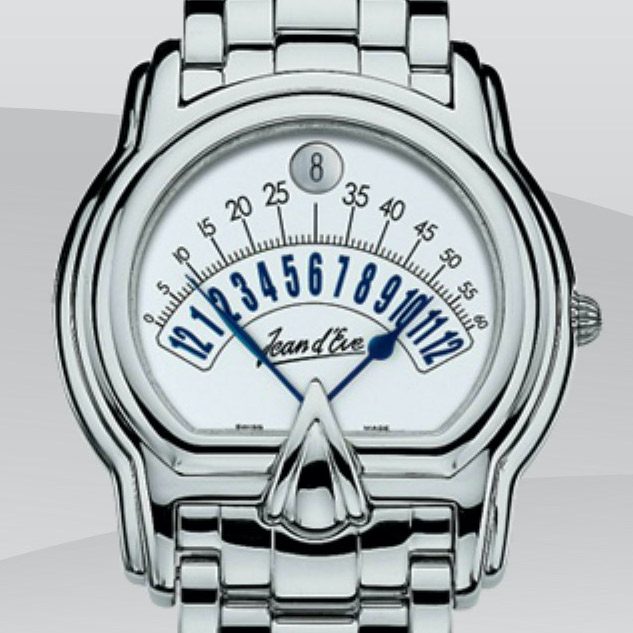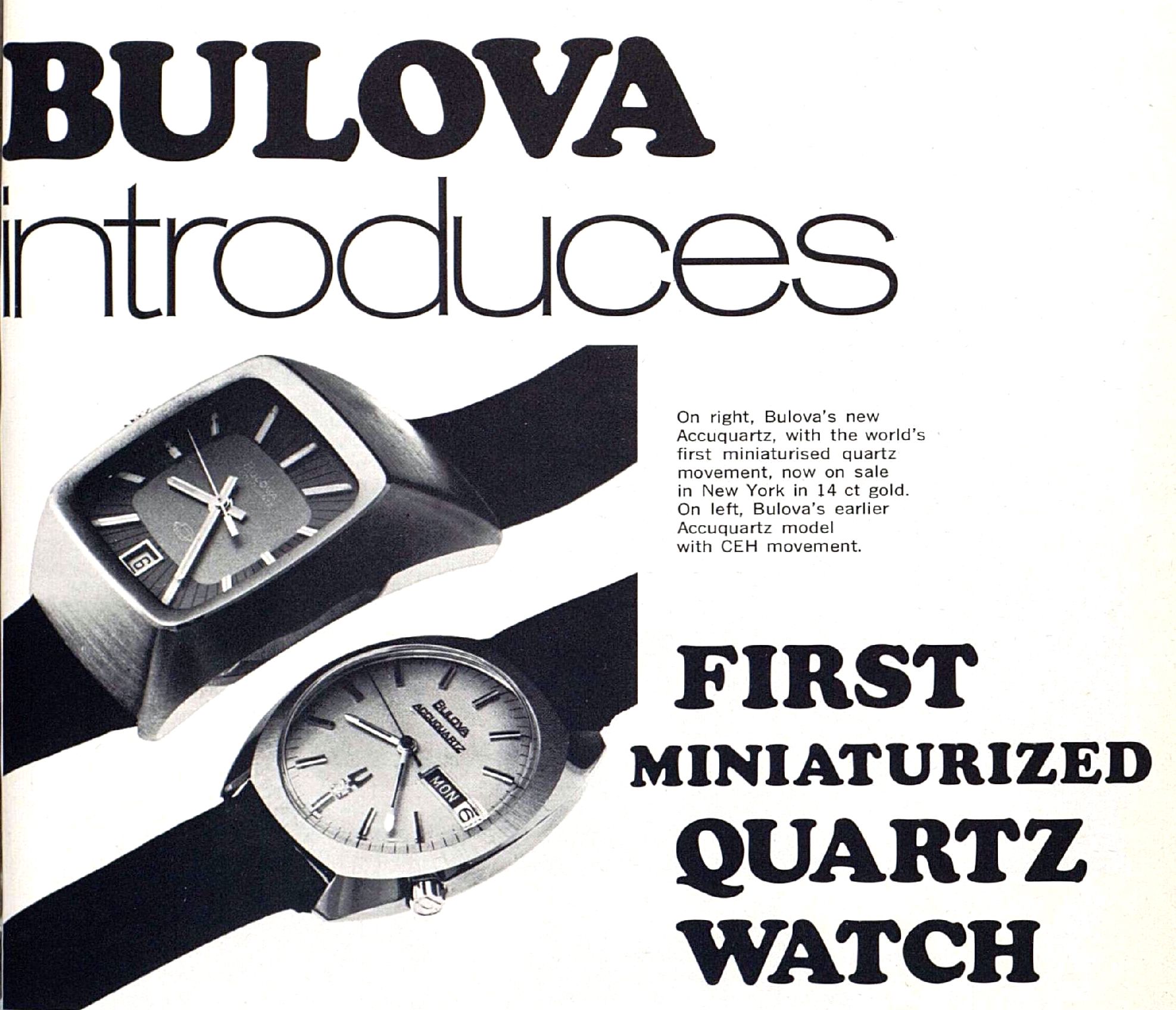
Browsing through the archives of Europa Star, I came across a groundbreaking watch I had never encountered. The Jean d’Eve Samara was not just the world’s first automatic-winding quartz watch, it was also a remarkably novel design! My research rabbit-hole lead me to learn not just about this watch but about an entire dark corner of horology. Naturally, I found a great example for sale as well!
Le Phare Jean d’Eve, Master of Complications?
I recently joined the Europa Star Club, allowing access to 70 years of the seminal watch market magazine’s archives. Although the pages are watermarked, one can pay to download pristine scans on a per-page basis. This will prove invaluable in my research and will give me the ability to add wonderful reference material to my posts! Many of the illustrations and information in this article come from Europa Star or their sister magazine, Eastern Jeweller and Watchmaker.
While browsing, I was struck by the design of Le Phare watches, which were frequently featured in the 1960s and 1970s. Here was a progressive brand producing novel and masculine watches, predominately chronographs but also divers. I quickly set about learning more about the brand, discovering that Le Phare dated to 1888 in Le Locle and was indeed a respected pioneer of complicated watches for men. Having moved to La Chaux-de-Fonds in 1939, the brand continued through the quartz crisis.
Learn more about the Schwarz-Etienne family in this article about their La Chaux-de-Fonds showroom!
Le Phare soon became associated with another local company, Sultana. The Schwarz family, best known for the Venus watch brand (which is not related to Vénus, the legendary chronograph maker), became involved with both Le Phare and Sultana and by 1963, Le Phare and Sultana were sharing a single booth at the Basel Fair. By 1973, the firms had merged, forming Le Phare-Sultana SA in La Chaux-de-Fonds.
In 1981, Le Phare-Sultana launched the upscale Jean d’Eve brand while simultaneously retiring the “Le Phare” name on watch dials. The signature Jean d’Eve model was the Spinnaker dress watch, which had a rope-like bezel and appears to have been successful throughout the 1980s. Indeed, it was featured on the cover of Europa Star in 1983.
Le Phare-Sultana was acquired in 1991 by Renley Watch Manufacturing, along with another Swiss company, Buler Quartz SA of Lengnau. Founded in 1983 by Hong Kong-based Stanley Lau, Renley was a private label producer of Swiss and French watches with Swiss movements. Sultana and Jean d’Eve continued until at least 2017, again sharing a booth at BaselWorld. The last Sultana-signed watch I could find dated to 1998, however, with just Jean d’Eve visible after this.

Jean d’Eve Sultana: Automatic Quartz
In the 1980s, Jean d’Eve was a rising brand with a hit product line, the Spinnaker, but it lacked any real watchmaking credibility. The company found the answer at the University of Eindhoven, where engineers had developed a system that could power a quartz watch movement using a winding rotor, as on an automatic watch. The company licensed and developed the technology in association with Kinetron BV of La Chaux-de-Fonds and French consulting firm, Conseil Ray, intent on creating the first automatic quartz watch.

The result was the Jean d’Eve Samara, a watch with revolutionary engineering and styling that earned a spot on the front cover of Europa Star and a great deal of buzz at BaselWorld. The Samara is named for the spinning seed pods of various trees, which resembled the watch rotor. Placed on the dial side between the movement and hands, the Samara “Generator system” wound an intermediate spring until power was released in a burst to spin up a multi-polar generator to 15,000 rpm. Each revolution of the rotor would power the spring through 8 cycles of this instantaneous un-latch/charge/latch cycle. This charged up a condenser with enough power to run the watch for 10 days. Once stopped, the watch could be recharged using an “Energizer” accessory.
By the time the Samara was released, Seiko had already debuted their Automatic Generator System (AGS), and they showed their first AGS Quartz watches at the same 1988 Basel show. Seiko AGS directly drove the generator up to 100,000 rpm using a geared rotor and thus did not rely on the Dutch patent. Seiko claimed they had been working on this solution since 1972, an internal project they now also credit as the foundation for today’s Spring Drive watch.

But the Seiko AGS can’t hold a candle to the Jean d’Eve Samara when it comes to horology or style. Although Seiko included a display caseback, their AGS Quartz models were extremely conservative. The Samara is anything but, with the rotor spinning dial-side below a transparent bubble in a case that looks more like the starship Enterprise than a watch. Designer Jean-François Donzé really outdid himself!
In two-tone steel and gold, the Samara was a pricy and unusual watch. The crown was mounted to the back, like a Jaeger-LeCoultre Futurematic, with a flip-out handle. Also on the back was the “nipple” to attach the included Energizer winding accessory. Although most photos show a leather strap, this example on Chrono24 features an original-looking steel and gold bracelet.


“Energizer” was an odd choice to name the portable power pack that “recharged” the Samara movement when stopped. In 1980, Eveready Battery Company used that same name on its flagship alkaline power cell, and Energizer remains a well-known trademarked name in the United States. Indeed, it is the name of the company today. Given the resemblance of the Jean d’Eve Energizer to an Energizer battery, this would certainly have posed an issue for American sales.
Jean d’Eve Today
In 1991, Le Phare-Sultana, owner of the Jean d’Eve brand, was sold to Hong Kong-based Renley Watch Manufacturing. The new owners invested in the brand, launching a series of high-profile promotions around sporting and art events and placing their watches on the wrist of celebrities. But new names like Jean d’Eve were unable to gain credibility as mechanical watches rebounded and classic names like Audemars Piguet, Jaeger-LeCoultre, and IWC invented today’s haute horology. As interesting as the Samara was, it was still a quartz watch.
ETA licensed the same patents as Jean d’Eve and introduced their Autoquartz movement line in 1996. These too featured an intermediate spring to drive the generator, but were designed for conservative watches. Indeed, the Tissot PR 100 was a thoroughly unremarkable watch apart from the display caseback, and was certainly at home in the market alongside Seiko’s re-named Kinetic. The ETA Autoquartz line wouldn’t even last a decade in the market. Perhaps the true successor to the Samara is the Ventura MGS, which used an oscillating rotor to power a digital LCD display.

Jean d’Eve did get some attention for their Sectora models, which featured retrograde hour and minute hands. These echoed a similar 1974 model from Le Phare, and capitalized on the crazy for retrograde hands. A 1999 refresh turned the seashell-shaped Sectora on its side, bringing renewed interest.
Another notable model for Jean d’Eve was the Quarta, a rectangular watch with retrograde hands at all four quarters. This earned a highlight in the August 2001 issue of WatchTime magazine, though the name of the model was misspelled “Quatra”, but coverage and attention waned.
In 2003, Jean d’Eve launched the Samara 2, a second-generation Samara in a rectangular case. This new movement featured 9 months reserve power and the watch styling was toned down. It featured engraved slab sides and an integrated bracelet. The radical dial-side rotor remained visible, though with a more modern “mechanical” appearance and no side visibility.

Renley fell into the hands of the next generation of the Lau family around this time, and became part of Free Town Watch Products. The company continued to press forward with the Jean d’Eve, Sultana, and Temporis brands, even exhibiting at BaselWorld in 2017, but this seems to have been the end of the line. The La Chaux-de-Fonds operation is reported to have few employees and manufacturing seems to be entirely in Hong Kong and mainland China now.
Notes and Errata
- US Patent 4,644,246
- US Patent 4,910,720
- US Patent 4,924,453
- International Patent PCT/NL83/00034
- À la Clinique Horlogère page “Jean D’Eve Samara”
Update April 17, 2020: Added one more photo of the Samara 2 from the Archive.org archives of the Jean d’Eve website.
Year
Country
Brand
Style
Material
Movement






Interesting read! I believe this movement may also have been used in the limited edition Accutron Spaceview II ( aka Spaceview 21) autoquartz of 2006-2008 or thereabouts. Ebay listings mention it and that movement certainly resembles this one.
I have a Tissot prc100 Autoquartz (ETA 205.911) and as of 2021 it’s been running with incredible accuracy on the same rechargeable battery since 2007.
I do believe you’re right! I had never heard of the Spaceview II but looking at eBay I see one that looks exactly like this Jean d’Eve movement. How odd! I will have to do more research!
Bulova made the space view for the 21st century in the year 2000 and 2001 under mdl # 26B06 and 28B64 using the Samara movement ..very cool watches and not easy to find today